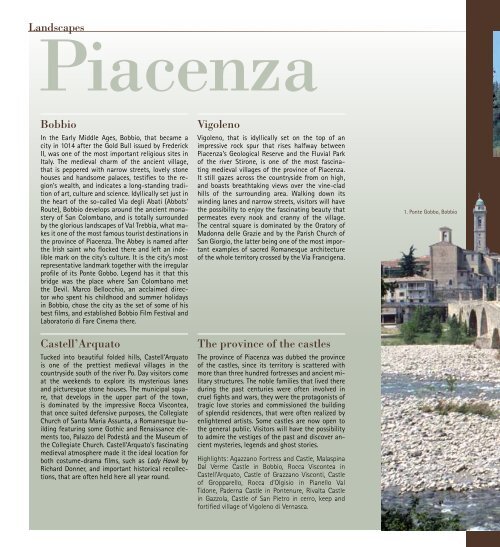of Emilia Romagna
of Emilia Romagna
of Emilia Romagna
You also want an ePaper? Increase the reach of your titles
YUMPU automatically turns print PDFs into web optimized ePapers that Google loves.
Landscapes<br />
Piacenza<br />
Bobbio<br />
In the Early Middle Ages, Bobbio, that became a<br />
city in 1014 after the Gold Bull issued by Frederick<br />
II, was one <strong>of</strong> the most important religious sites in<br />
Italy. The medieval charm <strong>of</strong> the ancient village,<br />
that is peppered with narrow streets, lovely stone<br />
houses and handsome palaces, testifies to the region’s<br />
wealth, and indicates a long-standing tradition<br />
<strong>of</strong> art, culture and science. Idyllically set just in<br />
the heart <strong>of</strong> the so-called Via degli Abati (Abbots’<br />
Route), Bobbio develops around the ancient monastery<br />
<strong>of</strong> San Colombano, and is totally surrounded<br />
by the glorious landscapes <strong>of</strong> Val Trebbia, what makes<br />
it one <strong>of</strong> the most famous tourist destinations in<br />
the province <strong>of</strong> Piacenza. The Abbey is named after<br />
the Irish saint who flocked there and left an indelible<br />
mark on the city’s culture. It is the city’s most<br />
representative landmark together with the irregular<br />
pr<strong>of</strong>ile <strong>of</strong> its Ponte Gobbo. Legend has it that this<br />
bridge was the place where San Colombano met<br />
the Devil. Marco Bellocchio, an acclaimed director<br />
who spent his childhood and summer holidays<br />
in Bobbio, chose the city as the set <strong>of</strong> some <strong>of</strong> his<br />
best films, and established Bobbio Film Festival and<br />
Laboratorio di Fare Cinema there.<br />
Castell’Arquato<br />
Tucked into beautiful folded hills, Castell’Arquato<br />
is one <strong>of</strong> the prettiest medieval villages in the<br />
countryside south <strong>of</strong> the river Po. Day visitors come<br />
at the weekends to explore its mysterious lanes<br />
and picturesque stone houses. The municipal square,<br />
that develops in the upper part <strong>of</strong> the town,<br />
is dominated by the impressive Rocca Viscontea,<br />
that once suited defensive purposes, the Collegiate<br />
Church <strong>of</strong> Santa Maria Assunta, a Romanesque building<br />
featuring some Gothic and Renaissance elements<br />
too, Palazzo del Podestà and the Museum <strong>of</strong><br />
the Collegiate Church. Castell’Arquato’s fascinating<br />
medieval atmosphere made it the ideal location for<br />
both costume-drama films, such as Lady Hawk by<br />
Richard Donner, and important historical recollections,<br />
that are <strong>of</strong>ten held here all year round.<br />
Vigoleno<br />
Vigoleno, that is idyllically set on the top <strong>of</strong> an<br />
impressive rock spur that rises halfway between<br />
Piacenza’s Geological Reserve and the Fluvial Park<br />
<strong>of</strong> the river Stirone, is one <strong>of</strong> the most fascinating<br />
medieval villages <strong>of</strong> the province <strong>of</strong> Piacenza.<br />
It still gazes across the countryside from on high,<br />
and boasts breathtaking views over the vine-clad<br />
hills <strong>of</strong> the surrounding area. Walking down its<br />
winding lanes and narrow streets, visitors will have<br />
the possibility to enjoy the fascinating beauty that<br />
permeates every nook and cranny <strong>of</strong> the village.<br />
The central square is dominated by the Oratory <strong>of</strong><br />
Madonna delle Grazie and by the Parish Church <strong>of</strong><br />
San Giorgio, the latter being one <strong>of</strong> the most important<br />
examples <strong>of</strong> sacred Romanesque architecture<br />
<strong>of</strong> the whole territory crossed by the Via Francigena.<br />
The province <strong>of</strong> the castles<br />
The province <strong>of</strong> Piacenza was dubbed the province<br />
<strong>of</strong> the castles, since its territory is scattered with<br />
more than three hundred fortresses and ancient military<br />
structures. The noble families that lived there<br />
during the past centuries were <strong>of</strong>ten involved in<br />
cruel fights and wars, they were the protagonists <strong>of</strong><br />
tragic love stories and commissioned the building<br />
<strong>of</strong> splendid residences, that were <strong>of</strong>ten realized by<br />
enlightened artists. Some castles are now open to<br />
the general public. Visitors will have the possibility<br />
to admire the vestiges <strong>of</strong> the past and discover ancient<br />
mysteries, legends and ghost stories.<br />
Highlights: Agazzano Fortress and Castle, Malaspina<br />
Dal Verme Castle in Bobbio, Rocca Viscontea in<br />
Castell’Arquato, Castle <strong>of</strong> Grazzano Visconti, Castle<br />
<strong>of</strong> Gropparello, Rocca d’Olgisio in Pianello Val<br />
Tidone, Paderna Castle in Pontenure, Rivalta Castle<br />
in Gazzola, Castle <strong>of</strong> San Pietro in cerro, keep and<br />
fortified village <strong>of</strong> Vigoleno di Vernasca.<br />
1. Ponte Gobbo, Bobbio
















